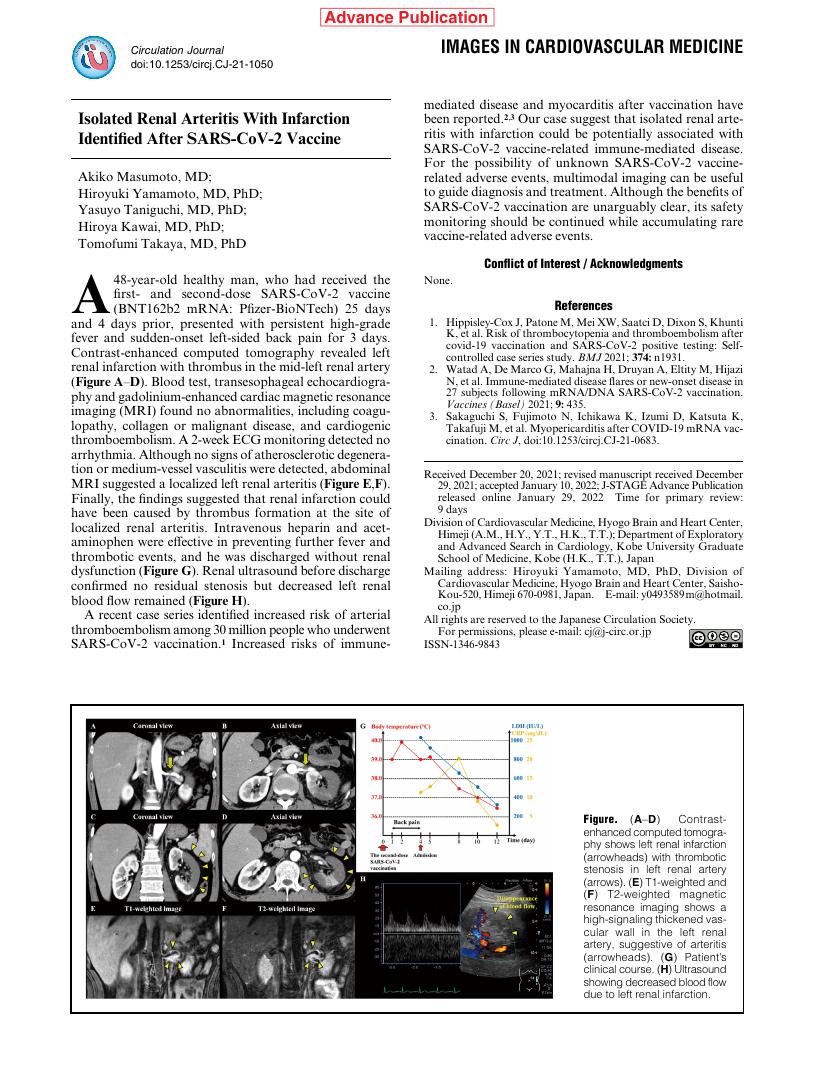- 著者
- Akiko Masumoto Hiroyuki Yamamoto Yasuyo Taniguchi Hiroya Kawai Tomofumi Takaya
- 出版者
- The Japanese Circulation Society
- 雑誌
- Circulation Journal (ISSN:13469843)
- 巻号頁・発行日
- pp.CJ-21-1050, (Released:2022-01-29)
- 参考文献数
- 3
- 被引用文献数
- 2
- 著者
- Shohei Yoshida Tomoaki Nakata Masanao Naya Mitsuru Momose Yasuyo Taniguchi Yoshimitsu Fukushima Masao Moroi Atsutaka Okizaki Akiyoshi Hashimoto Takatoyo Kiko Satoshi Hida Kazuya Takehana Kenichi Nakajima
- 出版者
- The Japanese Circulation Society
- 雑誌
- Circulation Reports (ISSN:24340790)
- 巻号頁・発行日
- pp.CR-23-0031, (Released:2023-04-28)
- 参考文献数
- 25
Background: Definitions of cardiac sarcoidosis (CS) differ among guidelines. Any systemic histological finding of CS is essential for the diagnosis of CS in the 2014 Heart Rhythm Society statement, but not necessary in the Japanese Circulation Society 2016 guidelines. This study aimed to reveal the differences in outcomes by comparing 2 groups, namely CS patients with or without systemic histologically proven granuloma.Methods and Results: This study retrospectively included 231 consecutive patients with CS. CS with granulomas in ≥1 organs was diagnosed in 131 patients (Group G), whereas CS without any granulomas was diagnosed in the remaining 100 patients (Group NG). Left ventricular ejection fraction (LVEF) was significantly reduced in Group NG compared with Group G (44±13% vs. 50±16%, respectively; P=0.001). However, Kaplan-Meier curves showed that major adverse cardiovascular events (MACE)-free survival outcomes were comparable between the 2 groups (log-rank P=0.167). Univariable analyses showed that significant predictors of MACE were Groups G/NG, histological CS, LVEF, and high B-type natriuretic peptide (BNP) or N-terminal pro BNP concentrations, but none of these was significant in multivariable analyses.Conclusions: Overall risks of MACE were similar between the 2 groups despite different manifestations in cardiac dysfunction. The data not only validate the prognostic value of non-invasive diagnosis of CS, but also show the need for careful observation and therapeutic strategy in patients with CS without any granuloma.
- 著者
- Takahiro Sawada Kenzo Uzu Naoko Hashimoto Tetsuari Onishi Tomofumi Takaya Akira Shimane Yasuyo Taniguchi Yoshinori Yasaka Takeshi Ohara Hiroya Kawai
- 出版者
- Japan Atherosclerosis Society
- 雑誌
- Journal of Atherosclerosis and Thrombosis (ISSN:13403478)
- 巻号頁・発行日
- pp.50807, (Released:2019-10-18)
- 参考文献数
- 41
- 被引用文献数
- 28
Aim: So far, the mechanisms behind the cardiovascular benefits of sodium/glucose cotransporter 2 (SGLT2) inhibitors have not been fully clarified. Methods: In order to evaluate the effects of SGLT2 inhibitors on systemic hemodynamics, glucose metabolism, lipid profile, and endothelial function, 50 diabetic patients with established coronary artery disease (CAD) were included in this analysis and were given empagliflozin 10 mg/d. Cookie meal testing (carbohydrates: 75 g, fats: 28.5 g), endothelial function testing using flow-mediated dilatation (FMD), and body composition evaluation were performed before and after six months of treatment. Changes in %FMD between the treatment periods and its association with metabolic biomarkers were evaluated. Results: After six months of treatment, the body weight and body fat percentage decreased significantly, while the body muscle percentage increased significantly. The hemoglobin A1c level and fasting and postprandial plasma glucose levels were significantly decreased with treatment. Postprandial insulin secretion was also significantly suppressed and the insulin resistance index was significantly decreased. Furthermore, the fasting and postprandial triglyceride (TG) levels decreased significantly, while total ketone bodies increased significantly after the six-month treatment. While the plasma brain natriuretic peptide level was not changed, the C-reactive protein level was decreased and FMD was significantly improved after the six-month treatment. Multiple regression analysis showed that the strongest predictive factor of FMD improvement is change in the plasma TG levels. Conclusion: SGLT2 inhibitors improve multiple metabolic parameters. Of these, a reduction in plasma TGs was strongly associated with endothelial function recovery in diabetic patients with CAD, and this reduction may be related to the cardiovascular benefits of SGLT2 inhibitors.
- 著者
- Akiko Masumoto Hiroyuki Yamamoto Yasuyo Taniguchi Hiroya Kawai Tomofumi Takaya
- 出版者
- The Japanese Circulation Society
- 雑誌
- Circulation Journal (ISSN:13469843)
- 巻号頁・発行日
- vol.86, no.7, pp.1144, 2022-06-24 (Released:2022-06-24)
- 参考文献数
- 3
- 被引用文献数
- 2
- 著者
- Takahiro Sawada Kenzo Uzu Naoko Hashimoto Tetsuari Onishi Tomofumi Takaya Akira Shimane Yasuyo Taniguchi Yoshinori Yasaka Takeshi Ohara Hiroya Kawai
- 出版者
- Japan Atherosclerosis Society
- 雑誌
- Journal of Atherosclerosis and Thrombosis (ISSN:13403478)
- 巻号頁・発行日
- vol.27, no.7, pp.644-656, 2020-07-01 (Released:2020-07-01)
- 参考文献数
- 41
- 被引用文献数
- 19 28
Aim: So far, the mechanisms behind the cardiovascular benefits of sodium/glucose cotransporter 2 (SGLT2) inhibitors have not been fully clarified. Methods: In order to evaluate the effects of SGLT2 inhibitors on systemic hemodynamics, glucose metabolism, lipid profile, and endothelial function, 50 diabetic patients with established coronary artery disease (CAD) were included in this analysis and were given empagliflozin 10 mg/d. Cookie meal testing (carbohydrates: 75 g, fats: 28.5 g), endothelial function testing using flow-mediated dilatation (FMD), and body composition evaluation were performed before and after six months of treatment. Changes in %FMD between the treatment periods and its association with metabolic biomarkers were evaluated. Results: After six months of treatment, the body weight and body fat percentage decreased significantly, while the body muscle percentage increased significantly. The hemoglobin A1c level and fasting and postprandial plasma glucose levels were significantly decreased with treatment. Postprandial insulin secretion was also significantly suppressed and the insulin resistance index was significantly decreased. Furthermore, the fasting and postprandial triglyceride (TG) levels decreased significantly, while total ketone bodies increased significantly after the six-month treatment. While the plasma brain natriuretic peptide level was not changed, the C-reactive protein level was decreased and FMD was significantly improved after the six-month treatment. Multiple regression analysis showed that the strongest predictive factor of FMD improvement is change in the plasma TG levels. Conclusion: SGLT2 inhibitors improve multiple metabolic parameters. Of these, a reduction in plasma TGs was strongly associated with endothelial function recovery in diabetic patients with CAD, and this reduction may be related to the cardiovascular benefits of SGLT2 inhibitors.

